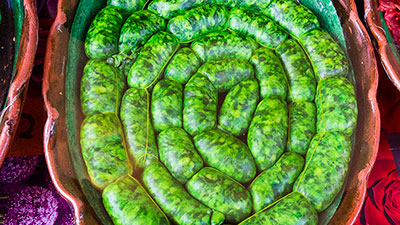Meats and Sausages
Chorizo Verde
Chorizo Verde (Green Chorizo) is a specialty sausage in the area of Toluca, Mexico. It gets its color from tomatillo (little tomato) also known as husk tomato or tomate verde (green tomato) which is native to Central America and Mexico.cayenne
Fresh chorizos are more popular in South American countries where the recipes are varied and do not necessarily follow the composition and processing steps of chorizos made in Spain.
| Materials | Metric | US |
|---|---|---|
| Pork shoulder | 1000 g | 2.2 lb |
Ingredients per 1000g (1 kg) of materials
| Salt | 12 g | 2 tsp |
| Pepper | 1.0 g | 1/2 tsp |
| Poblano chile | 200 g | 0.44 lb |
| Serrano chile | 15 g | 1 pepper |
| Chipotle chile, dried | 10 g | 3 peppers |
| Cayenne | 3.0 g | 1-1/2 tsp |
| Cilantro, fresh | 90 g | 3 oz |
| Tomatillos | 200 g | 0.44 lb |
| Garlic, smashed | 10 g | 3 cloves |
| Coriander | 4.0 g | 2 tsp |
| Cumin | 2.0 g | 1 tsp |
| Vinegar | 90 ml | 3 oz fl |
Instructions
- Roast poblano and serrano chile over a gas flame. Put them in a plastic bag to steam for about 20 minutes, as this will make removing the skins much easier. Remove the charred skins and chop the chile finely.
- Tear the dried chipotle and soak them in a little water.
- Stem and chop cilantro and tomatillos.
- Place vinegar and all ingredients in food processor and emulsify into a paste.
- Grind pork through 1/4” (5 mm) plate.
- Mix ground pork with emulsified paste.
- Stuff into 32-36 mm hog casings.
- Hold in refrigerator for 24 hours for the flavors to develop.
- Fry or grill before serving.
Notes
Tomatillo (little tomato) also known as husk tomato or tomate verde (green tomato) are native to Central America and Mexico.
Poblano is a mild chili pepper originating in the state of Puebla, Mexico. Dried, it is called ancho or chile ancho.
Chipotle is a smoke-dried jalapeño.
The serrano pepper is a type of chili pepper that originated in the mountainous regions of the Mexican states of Puebla and Hidalgo. Serrano is typically eaten raw and is much hotter than the jalapeño pepper.
Poblano is a mild chili pepper originating in the state of Puebla, Mexico. Dried, it is called ancho or chile ancho.
Chipotle is a smoke-dried jalapeño.
The serrano pepper is a type of chili pepper that originated in the mountainous regions of the Mexican states of Puebla and Hidalgo. Serrano is typically eaten raw and is much hotter than the jalapeño pepper.


















